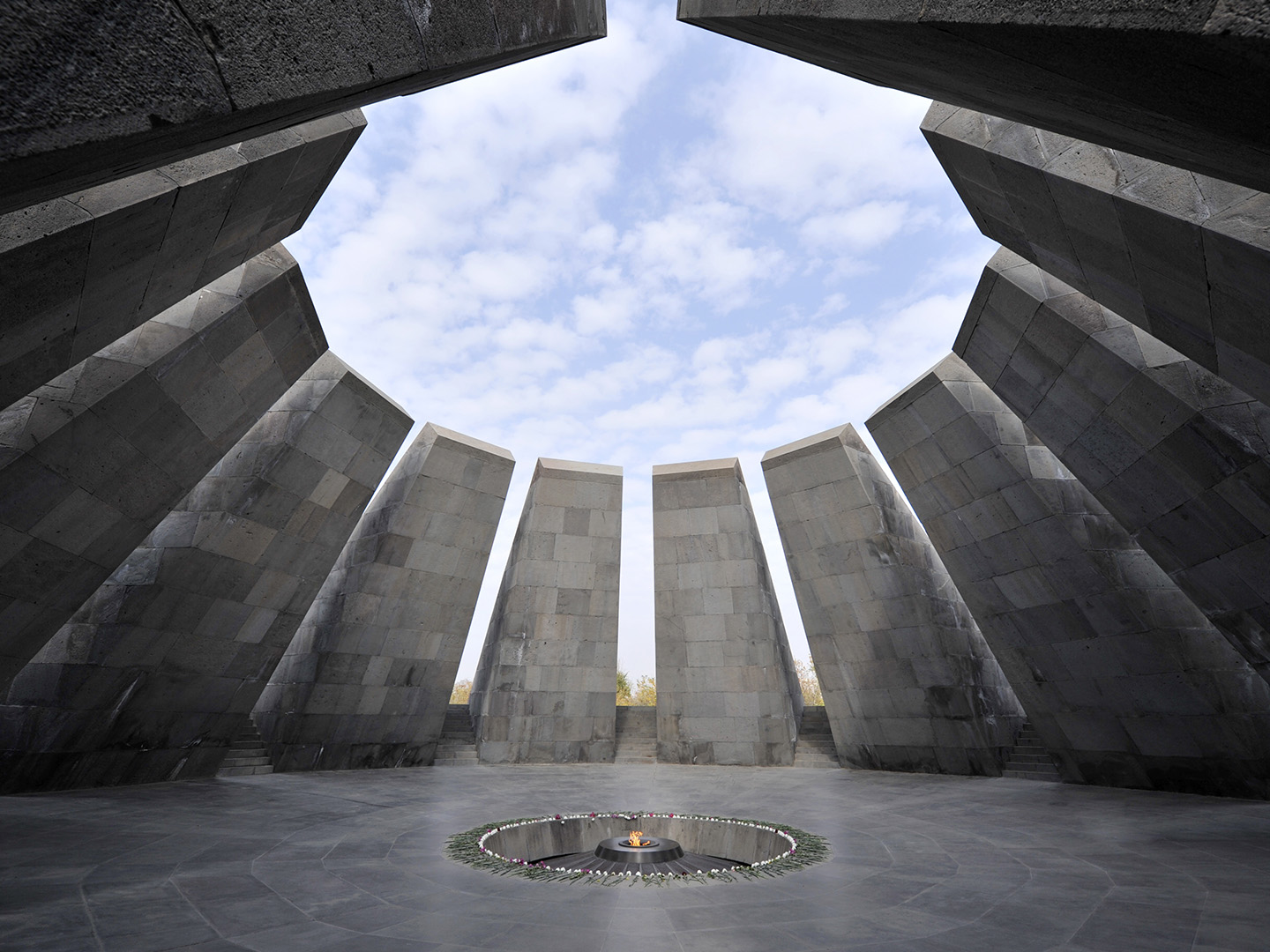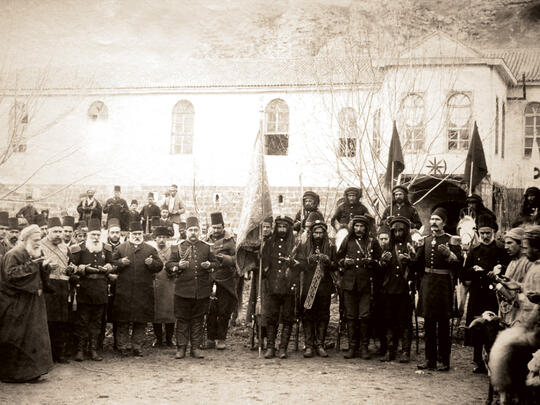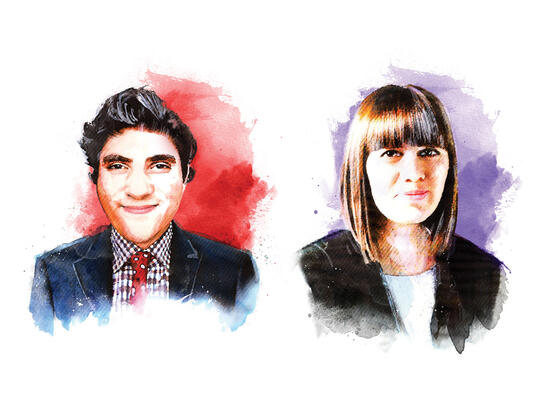Critically-acclaimed poet and non-fiction writer Peter Balakian is the Donald M. and Constance H. Rebar Professor in Humanities and professor of English at Colgate University. He is the author of seven books of poems and four prose works, including The Burning Tigris: The Armenian Genocide and America’s Response, a New York Times best seller and winner of the 2005 Raphael Lemkin Prize; and Black Dog of Fate, a memoir, winner of the PEN/Albrand Prize. Vise and Shadow: Essays on the Lyric Imagination, Poetry, Art, and Culture will be published by The University of Chicago Press.
Memory
Q: You were raised in New Jersey in a family where the Armenian Genocide was never openly discussed. Yet the genocide, and issues surrounding memory and historical trauma are central themes in much of your work. Why are they so important to you?
A: Every family who comes out of a survivor experience will have their own personal chemistry about the historical event they survived so there are many Armenian families for whom open conversation about that past happens early on. But in other families there was a kind of shutdown and psychic numbing, which is often a pattern among survivors, because the trauma of the event is so great that people find it is a survival technique.
As a writer, the richness and depth of this human and historical story engaged me deeply. Most of my books of poems from Father Fisheye (1979) on—have varying degrees of engagement with Armenian cultural and historical memory. My memoir Black Dog of Fate deals with the transmission of trauma across generations in a family that refused to speak about the Armenian past. As for the social justice issues, these are important ethical issues that haunt the aftermath of the Turkish eradication of Armenian culture and remain contemporary and significant. The Armenian community worldwide is clearly interested in pursuing some form of social justice.
Q: What have been the costs of denial of the genocide, of that existence and memory over the past century?
A: Nobody can really assess the costs, except to say that denialism is harmful, psychologically, emotionally and morally to the survivor legacy communities. And our scholars of genocide remind us that denial is the final stage of genocide because it seeks to demonize victims and rehabilitate the perpetrators, and it sends a message that genocide demands no moral accountability. It also emboldens future genocidaires to pursue paths of mass violence. I often think of Elie Wiesel’s statement that denial is a “double killing” because it strives to kill the memory of the event. In the collective memory of the event ethical dimensions reside, and it’s also been pointed out that denialism seeks to create what Robert Jay Lifton has called a morally counterfeit universe for the legacy community. I think denialism is also damaging for the perpetrator culture and its legacy because those who are following the call of their government to deny this for the sake of national honor—those people are being misled and being led into a kind of anger and confusion they don’t really understand. Such behavior undermines the development of compassion, empathy and an awareness of the other.
I certainly feel the unethical nature of the aggressive and misguided anger from the Turkish nationalists. I see them as victims of their government’s misguided and confused policy. And I like to recall what President Obama said to the Turkish government inside Turkey’s parliament in 2009: “an unresolved history is too big a burden to carry, take it from me as an American, you must deal with the facts of 1915 honestly.” He’s right. Turkey would help itself in many ways to stop playing this game of combating the Armenian Genocide. It’s also disturbing to go to Turkey and see the erasure of the rich, historically deep Armenian past of Anatolia. When you go to Ani and see this great remnant of Armenia’s most important medieval city and see that the Turkish Ministry of Tourism will not even allow the word Armenia/Ermeni on any of the signage at this major tourist site. This is another manifestation of denialism that contributes to the moral counterfeiting and protracted violence against the eradicated culture.
Recognition
Q: To what extent has the growth of research and increase in public awareness, as well as the marked change in general attitudes and efforts of brave scholars within Turkey brought Armenians closer to achieving social justice and restitution?
A: I’m sure it has brought us closer to some forms of social justice and restitution. What is happening in Turkey today was hard to imagine a decade ago. There are now conferences and lectures that deal with the Armenian past and with the genocide. A half dozen commemorations will happen inside Turkey this year.
Discussions about the Armenian genocide took place on Turkish television. A sign in Diyarbakir reads: “Welcome to Diyarbakir” in Armenian. The knowledge that has been produced internationally by scholars from Australia, Europe, South America, North America and the Middle East, and especially by Turkish scholars, writers and journalists has had an impact on the mindset inside of Turkey. People like Ragip Zarakolu, the great publisher who published many of our books and many other books about the Greek and Kurdish past, have made such a big difference. Scholars like Taner Akçam, Fatma Müge Goçek, and Uğur Ümit Üngör, journalists, and the Turkish Human Rights Organization as well as the Hrant Dink Foundation are making a difference. Hrant’s assassination has become a martyrdom of enormous significance. So I think one just has to stay hopeful and also note that you can’t predict how nation states and governments are going to configure their own ideologies as time passes. Martin Luther King Jr. tried to answer that in a way in the 1950s and 1960s when he famously said the arc of history bends towards justice. I think it’s hopeful to recall that.
Q: Some have argued had the international community recognized the Armenian Genocide and punished its perpetrators, the Jewish Holocaust and subsequent genocides may have been averted. One hundred years later, what can the international community and particularly the United States, do to help redress their historic failure and ultimately help Armenians heal the wounds of the past?
A: I’m not sure the Holocaust would have been averted. But formal international justice after the Armenian Massacres might have created a different human rights climate. I think the US has to take on a little more moral leadership here and first acknowledge with some pride its own past in the American relief and rescue movements for the Armenians in the 1890s through the 1920s. In fact Americans broke ground in their relief efforts for the Armenian victims and survivors of the Hamidian massacres of the 1890s by sending the first Red Cross mission ever out of the country in 1896-97 led by Clara Barton. And US foreign office reports on the massacres of the Armenians constitute the first American eyewitness accounts of genocide in our foreign diplomatic history. It’s a noble record. But today, the US State Department is afraid to acknowledge its own history for fear of Turkish anger and reprisal. It’s an embarrassing game for the United States. The US looks foolish in the eyes of the world. Other nations have had no problem dealing with the Armenian past. If you go to France as I did on a book tour with other Armenian writers in 2011, you can’t believe how warmly you are greeted by the French government and they honor you for your work. In the US that would never happen because there is so much fear and paranoia about Turkey and there is something immature here about the State Department’s inability to move forward on this issue. The US has many issues on its plate but this one seems quite doable—it’s not going to cost the US a lot. Maybe there will be some momentary anger from Ankara but the US is the empire in this conversation. I think it’s a failure of a democracy if our government can’t stand up for its own history because of pressure from a foreign government. The case of the famous orphan rug makes this clear. The White House was unable to write an accurate narrative about the Armenian orphan rug when it was put on display because of its fear of Turkey. Does this makes sense? In a country that espouses a free and open democracy.

Legacy
Q: What will be the legacy of the Armenian genocide for future generations?
A: I think in many ways knowledge about the Armenian genocide is valuable, rich, complex and important. I disagree with Meline Toumani’s unexamined and simplistic assertion in her recent book that the Armenian Genocide issue is “destroying” Armenians. (Though there is much to admire in Toumani’s book). It may be true that some people in the community have had negative psychological effects from being angry or traumatized, and I think that the misguided ASALA killings of the 1980s were horrible. This shows you what can happen when human rights crimes are carried out with impunity and then followed by the perpetrator legacy’s regimes that engage in an aggressive campaign to blame and demonize the victims and rehabilitate themselves.
Nevertheless, I think the study of the Armenian Genocide—from what I’ve seen as a teacher and writer over decades now—has been a positive and creative force. First, a whole generation of Armenians (and Americans of course!) have opened up new arenas of study and discourse. I say this noting that I don’t think every Armenian needs to be involved with this issue or study this issue. Nor do I think this issue is somehow essential to being an Armenian. I’ve said many times to many audiences over the years that Armenian culture is a rich sedimentary rock with dozens of places of intersection. If you want to study the engineering feats of the Armenian architect Trdat in the late 10th century, you’ll be wrapped up in Armenian culture in a rich way; and there are dozens of such entries into the Armenian culture.
But I do think that the knowledge about histories of mass killing and about genocide is important knowledge for citizens of the planet to have and the Armenian case provides much to study. And the thing I stress with my students is that each case whether it be focused on the Armenians, the Jews, the Roma, the Cambodians, the Bosnian Muslims, or the Tutsi, affords us understanding about the consequences of social and cultural infrastructures of intolerance, bigotry, and the failure of egalitarian and democratic social and political structures. And each case affords us an analysis of the complexity of historical contexts for each different event.
Studying the Armenian Genocide has universal value. Not only is the knowledge such study imparts intellectually important, but the ethical issues it engages students in are many and pertain to trying to solve human rights problems across the globe today. Over the years I keep reiterating to Armenian audiences that to be connected to the legacy of the Armenian genocide is a call for one to work for others—and to be connected to contemporary human rights issues both here in the US and abroad. In my own work with my former student Maggie Dunne’s Lakota Children’s Enrichment Fund, I find myself talking with the Sioux and Lakota people about the Armenian past—and I keep hearing their stories and their issues in relation to the Armenian and other post-genocide narratives. Armenians have a great opportunity to take moral leadership to either a local or global arena because of their knowledge of the harsh Armenian past.
Another legacy of the Armenian genocide has been the powerful impact the event has had on the Armenian imagination over the past, say, eighty years. Here I think one of the legacies of a history of great trauma is that powerful and rich literature and art has come out of it. Something affirmative comes out of the atrocity that offers meaning, insight, complexity and value. And that literature and art comes in various idioms and forms and with its many symbolic structures. Here, I think Marianne Hirsch’s notion of post-memory (the impact of a historical event on those who come after) is essential for understanding the dynamics of much of Armenian American literary and visual culture of the past 80 years. I start with some of Saroyan’s short stories of the 1930s like “Seventy Thousand Assyrians,” and “General Antranik,” and go on to the post war generation; and a wide range of writers and artists I admire including Peter Sourian, David Kherdian, Michael Arlen, Jr., Gregory Djankikian, Diana Der Hovanessian, Nancy Kricorian, Micheline Marcom, Viken Berberian, Christopher Bohjalian, Aris Janigian, Richard Kalinoski, Leslie Ayvazian, Alex Delynaris, Eric Bogosian; visual artists Arshile Gorky, Robert Barsamian; composers, Alan Hovhaness, Michell Ekezian; filmmakers Atom Egoyan, Suzanne Khardalian; among others. My new book of essays Vise and Shadow offers some forays into both post memory and survivor generation literature and art. I would also recommend Walter Kalaidjian’s book The Edge of Modernism and Maria Koundoura’s Transnational Culture, Transnational Identity. Armenian Americans have contributed a significant body of literature to American literature and to a wider transnational literature.
Q: Looking back at the collective Armenian “arc of history” over the last one hundred years, what stands out in your mind?
A: Armenian culture worldwide generally speaking seems to be thriving, prosperous, and high-energy. If we look back at the significance of 100 years, it is perhaps astonishing that Armenian civilization which was nearly extinguished in 1915, has emerged as it has today—as a vital, prosperous and creative culture—perhaps more so than ever in modern Armenian history. I say this cognizant of all the problems it faces and all the complex issues that lie ahead to be solved.
Banner photo by Tanya Kechichian
















